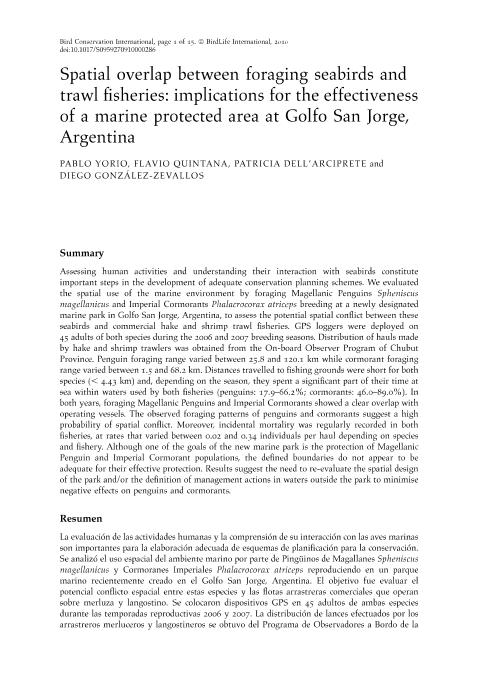Mostrar el registro sencillo del ítem
dc.contributor.author
Yorio, Pablo Martin

dc.contributor.author
Quintana, Flavio Roberto

dc.contributor.author
Dell'arciprete, Olga Patricia

dc.contributor.author
Gonzalez Zevallos, Diego Ricardo

dc.date.available
2020-01-09T20:06:04Z
dc.date.issued
2010-09
dc.identifier.citation
Yorio, Pablo Martin; Quintana, Flavio Roberto; Dell'arciprete, Olga Patricia; Gonzalez Zevallos, Diego Ricardo; Spatial overlap between foraging seabirds and trawl fisheries: Implications for the effectiveness of a marine protected area at Golfo San Jorge, Argentina; Cambridge University Press; Bird Conservation International; 20; 3; 9-2010; 320-334
dc.identifier.issn
0959-2709
dc.identifier.uri
http://hdl.handle.net/11336/94205
dc.description.abstract
La evaluación de las actividades humanas y la comprensión de su interacción con las aves marinas son importantes para la elaboración adecuada de esquemas de planificación para la conservación. Se analizó el uso espacial del ambiente marino por parte de Pingüinos de Magallanes Spheniscus magellanicus y Cormoranes Imperiales Phalacrocorax atriceps reproduciendo en un parque marino recientemente creado en el Golfo San Jorge, Argentina. El objetivo fue evaluar el potencial conflicto espacial entre estas especies y las flotas arrastreras comerciales que operan sobre merluza y langostino. Se colocaron dispositivos GPS en 45 adultos de ambas especies durante las temporadas reproductivas 2006 y 2007. La distribución de lances efectuados por los arrastreros merluceros y langostineros se obtuvo del Programa de Observadores a Bordo de la Provincia de Chubut. El rango de forrajeo de los pingüinos varió entre 25,8 y 120,1 km mientras que el de los cormoranes vario´ entre 1,5 y 68,2 km. En ambas especies, las distancias recorridas desde las colonias a las áreas de pesca fueron cortas (, 4,43 km) y, dependiendo del año, las aves pasaron una parte significativa de su tiempo en el mar dentro de áreas utilizadas por ambas pesquerías (pingüinos: 17,9– 66,2%; cormoranes: 46,0–89,0 %). En ambos años, las áreas de alimentación de pingüinos y cormoranes mostraron una clara superposición con las zonas de operación de ambas pesquerías. Los patrones de forrajeo observados para los pingüinos y cormoranes sugieren una alta probabilidad de conflicto espacial con las flotas pesqueras. Es más, se registró mortalidad incidental de aves en ambas pesquerías, con valores que oscilaron entre 0,02 y 0,34 individuos por lance dependiendo de la especie y la pesquería. Aunque uno de los objetivos del nuevo parque marino es la protección de las poblaciones del Pingüino de Magallanes y del Cormorán Imperial, los límites definidos del área protegida no parecerían ser adecuados para su protección efectiva. Los resultados sugieren la necesidad de re evaluar el diseño espacial del parque y/o definir acciones de manejo en aguas por fuera del parque para minimizar los efectos negativos sobre pingüinos y cormoranes.
dc.description.abstract
Assessing human activities and understanding their interaction with seabirds constitute important steps in the development of adequate conservation planning schemes. We evaluated the spatial use of the marine environment by foraging Magellanic Penguins Spheniscus magellanicus and Imperial Cormorants Phalacrocorax atriceps breeding at a newly designated marine park in Golfo San Jorge, Argentina, to assess the potential spatial conflict between these seabirds and commercial hake and shrimp trawl fisheries. GPS loggers were deployed on 45 adults of both species during the 2006 and 2007 breeding seasons. Distribution of hauls made by hake and shrimp trawlers was obtained from the On-board Observer Program of Chubut Province. Penguin foraging range varied between 25.8 and 120.1 km while cormorant foraging range varied between 1.5 and 68.2 km. Distances travelled to fishing grounds were short for both species (< 4.43 km) and, depending on the season, they spent a significant part of their time at sea within waters used by both fisheries (penguins: 17.9-66.2%; cormorants: 46.0-89.0%). In both years, foraging Magellanic Penguins and Imperial Cormorants showed a clear overlap with operating vessels. The observed foraging patterns of penguins and cormorants suggest a high probability of spatial conflict. Moreover, incidental mortality was regularly recorded in both fisheries, at rates that varied between 0.02 and 0.34 individuals per haul depending on species and fishery. Although one of the goals of the new marine park is the protection of Magellanic Penguin and Imperial Cormorant populations, the defined boundaries do not appear to be adequate for their effective protection. Results suggest the need to re-evaluate the spatial design of the park and/or the definition of management actions in waters outside the park to minimise negative effects on penguins and cormorants.
dc.format
application/pdf
dc.language.iso
eng
dc.publisher
Cambridge University Press

dc.rights
info:eu-repo/semantics/openAccess
dc.rights.uri
https://creativecommons.org/licenses/by-nc-sa/2.5/ar/
dc.subject
FORAGING SEABIRDS
dc.subject
FISHERIES
dc.subject
SPATIAL OVERLAP
dc.subject
MARINE PROTECTED AREAS
dc.subject.classification
Ecología

dc.subject.classification
Ciencias Biológicas

dc.subject.classification
CIENCIAS NATURALES Y EXACTAS

dc.subject.classification
Ecología

dc.subject.classification
Ciencias Biológicas

dc.subject.classification
CIENCIAS NATURALES Y EXACTAS

dc.title
Spatial overlap between foraging seabirds and trawl fisheries: Implications for the effectiveness of a marine protected area at Golfo San Jorge, Argentina
dc.type
info:eu-repo/semantics/article
dc.type
info:ar-repo/semantics/artículo
dc.type
info:eu-repo/semantics/publishedVersion
dc.date.updated
2019-11-25T18:00:05Z
dc.journal.volume
20
dc.journal.number
3
dc.journal.pagination
320-334
dc.journal.pais
Reino Unido

dc.journal.ciudad
Cambridge
dc.description.fil
Fil: Yorio, Pablo Martin. Consejo Nacional de Investigaciones Científicas y Técnicas. Centro Nacional Patagónico; Argentina. Wildlife Conservation Society; Estados Unidos
dc.description.fil
Fil: Quintana, Flavio Roberto. Consejo Nacional de Investigaciones Científicas y Técnicas. Centro Nacional Patagónico; Argentina. Wildlife Conservation Society; Estados Unidos
dc.description.fil
Fil: Dell'arciprete, Olga Patricia. Consejo Nacional de Investigaciones Científicas y Técnicas. Centro Nacional Patagónico; Argentina
dc.description.fil
Fil: Gonzalez Zevallos, Diego Ricardo. Consejo Nacional de Investigaciones Científicas y Técnicas. Centro Nacional Patagónico; Argentina
dc.journal.title
Bird Conservation International

dc.relation.alternativeid
info:eu-repo/semantics/altIdentifier/doi/http://dx.doi.org/10.1017/S0959270910000286
dc.relation.alternativeid
info:eu-repo/semantics/altIdentifier/url/https://www.cambridge.org/core/journals/bird-conservation-international/article/spatial-overlap-between-foraging-seabirds-and-trawl-fisheries-implications-for-the-effectiveness-of-a-marine-protected-area-at-golfo-san-jorge-argentina/DD812F003A54E6EA57F7250894634EDB
Archivos asociados
